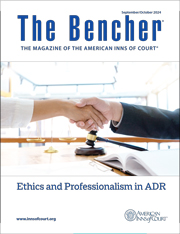The Bencher | September/October 2024
Back to Basics: Technological Competence and Confidentiality
By Judge Michael K. Newell and Ryan P. Newell, Esquire


 In the midst of a technological revolution in which courts and lawyers are integrating generative artificial intelligence (AI) technology that could transform the profession, the highest court in the land failed to simply scrub metadata from an opinion. As reported by the American Bar Association (ABA) and legal news outlets, a unanimous decision by the Supreme Court of the United States was apparently a partial dissent at some juncture in the drafting process. The unintended consequence was a teaching moment for the profession. To protect client confidentiality, we cannot forget the basic fundamentals of technological competence.
In the midst of a technological revolution in which courts and lawyers are integrating generative artificial intelligence (AI) technology that could transform the profession, the highest court in the land failed to simply scrub metadata from an opinion. As reported by the American Bar Association (ABA) and legal news outlets, a unanimous decision by the Supreme Court of the United States was apparently a partial dissent at some juncture in the drafting process. The unintended consequence was a teaching moment for the profession. To protect client confidentiality, we cannot forget the basic fundamentals of technological competence.
Model Rules 1.1 and 1.6: Under ABA Model Rule of Professional Conduct 1.6, “[a] lawyer shall not reveal information relating to the representation of a client unless the client gives informed consent, the disclosure is impliedly authorized in order to carry out the representation or the disclosure is [otherwise] permitted…” In addition to refraining from the foregoing, an attorney must affirmatively “make reasonable efforts to prevent the inadvertent or unauthorized disclosure of, or unauthorized access to, information relating to the representation of a client.” On top of that, in satisfying the competence requirement under Rule 1.1, an attorney must “keep abreast of changes in the law and its practice, including the benefits and risks associated with relevant technology…” The Supreme Court’s inadvertent error has served as a good reminder for all attorneys to revisit some basic technological skills.
Track Changes: Metadata, such as track changes, is as much a part of a document as the text on the screen. Whether visible or not, attorneys must be mindful of its existence. For example, do your track changes reflect privileged attorney-client communications or work product? If so, a metadata scrubber should be used before sharing a draft reflecting such privileged and confidential matters to remove such information before it is shared with an adversary. Conversely, if a document must be preserved for discovery, then the metadata should be preserved. It is discoverable information.
Email: When verbally discussing client matters, most attorneys consider what they divulge, to whom they divulge it, and how they divulge it. For example, the most important privileged information is unlikely to be discussed in the middle of a public setting. Likewise, with email, attorneys should consider whether their emails have adequate security. Not all emails need to be encrypted, but highly sensitive or confidential communications may warrant encryption. Attorneys should be transparent with their clients and, if necessary, obtain consent to convey all or certain confidential client communication via email.
Document Management: In addition to encryption, attorneys need to consider whether their document management service provider claims ownership over the data stored with that provider. In addition, it is important to know “where” that data is stored. It may not be in the same jurisdiction as the attorney’s office and, as a result, may be subject to different laws regarding retention and disclosure.
Research: By now, most attorneys should be on notice to be wary about disclosing client confidential information to the well-known generative AI platforms. That data can be used to train the model and is no longer confidential. But those same concerns may exist with internet search platforms that have begun integrating similar generative AI capabilities—unbeknownst to many attorneys.
Networking: While more public Wi-Fi networks are encrypted than previously, certain networks remain unencrypted. Again, knowing whether confidential information is being disclosed to third parties on an unencrypted network is imperative to complying with Rule 1.6.
Tips for Judges: Judicial officers and courts are not immune to the risks of technology. Judicial clerks should make sure that opinions and orders are scrubbed to remove metadata before they are published to court websites or issued to the attorneys/parties. In the Family Court of Delaware, we redact sensitive data before we issue our decisions. However, please note that using “no color highlighting” does not redact the document. No color highlighting can reveal the underlying text by putting a PDF document in Word, thus revealing the underlying text.
These are but a handful of common issues facing most attorneys and judges on a routine basis. It is easy to get distracted by the fancy new technology. But unless attorneys and judges focus on basic competences with the technology that they interact with multiple times a day, then the likelihood of confidentiality breaches remains high.
Michael K. Newell is the chief judge of the Family Court of the State of Delaware. He is a member and past president of the Melson-Arsht American Inn of Court and a member of the Richard K. Herrmann Technology American Inn of Court in Wilmington, Delaware. Ryan P. Newell, Esquire, is a partner at Young Conaway Stargatt & Taylor, LLP in Wilmington, Delaware. He is president of the Richard K. Herrmann Technology American Inn of Court.